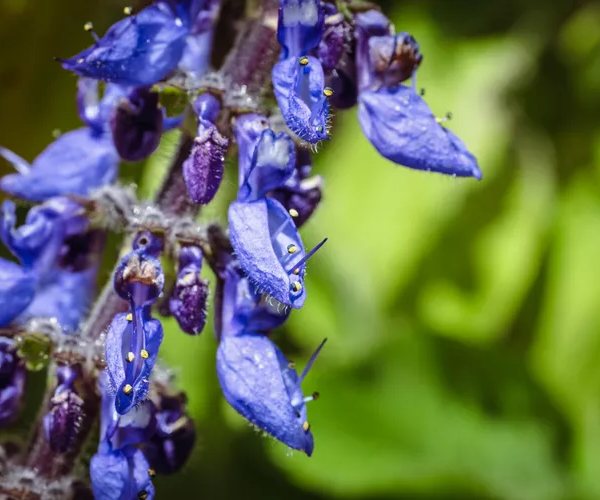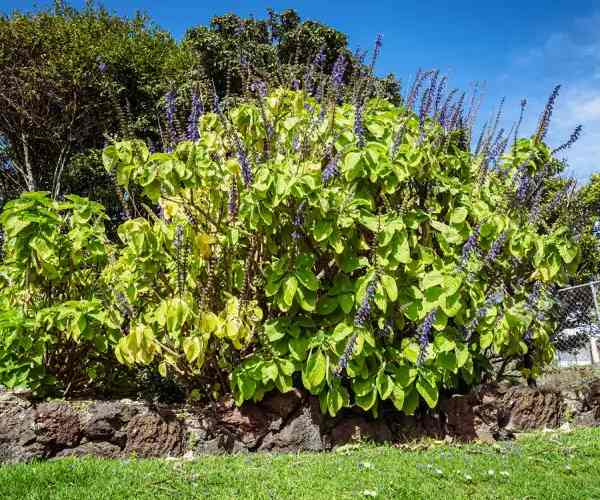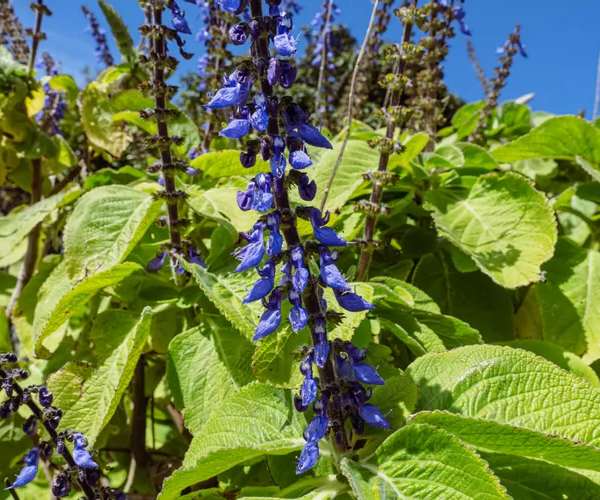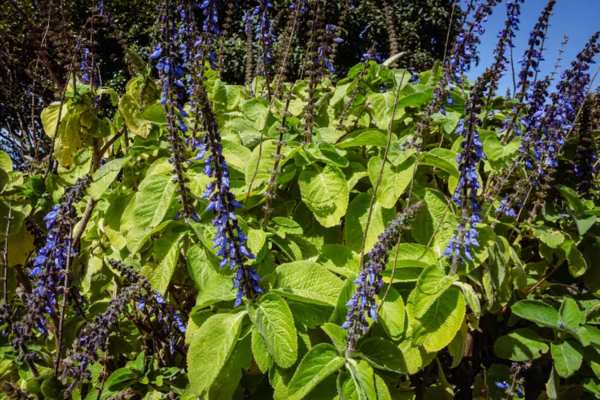Blue Spur flower, also famously known as Plectranthus barbatus and Coleus barbatus, is a large upright bushy plant with blue-purple flowers, making it ideal for garden beds. This plant loves partial sunlight, mild warm temperatures, and nutrient-rich soil, and it is somewhat drought-tolerant.
Plant Attributes
- Common Name: Blue spur flower, candlestick plant
- Botanical Name: Plectranthus barbatus, Coleus barbatus
- Family: Lamiaceae
- Plant Type: Perennial
- Mature Size: 5-8 ft. tall, 5-8 ft. wide
- Sun Exposure: Full, partial
- Soil Type: Moist but well-draining
- Bloom Time: Fall. winter, and spring
- Flower Color: Blue, Purple
- Hardiness Zones: 9-11 (USDA)
- Native Area: Africa
Blue Spur Flower Care
Blue Spur consists of vibrant blooms and an attractive presence and it is a fairly easy-to-care-for plant that will make your garden look beautiful. Here are some requirements for caring for this plant.

- Choose a sunny spot for this plant mainly with partial sunlight. That said, Blue Spur can tolerate full sun also.
- Prepare a nutrient-full, well-draining soil before planting.
- Regular watering is needed but do not let it be water-logged as it can damage the roots of the plant.
- Amendment of the soil with compost every year is essential.
Light
As mentioned above, most Blue Spurs can tolerate full sun but they thrive in partial sunlight. Their natural habitat is forests or river banks that get filtered light. Therefore, creating this kind of lighting will create a healthy space for its specimens.
If you are planting it indoors, choose a spot that receives bright, indirect lighting for best results.
Also, Read Should You Add Banana Water and Eggshells to Your Plants? Experts Reveal!
Soil
These plants require rich soil like that in the forest. Therefore, adding some organic matter or compost to the soil before planting Blue Spur Flower will create a fertile environment for it. Adding these matters will also help in drainage and lessen overwatering problems.
Water
As the Plectranthus genus is drought-resistant, this plant is not that choosy when it comes to overwatering. While regular watering is beneficial in a lot of ways, you must not water it every day. If you live in a place that has a dry, hot climate, you may have to require to water it more often to keep it healthy.

That being said, make sure that you do not overwater as this can ultimately kill your plant. Only water when the top inch of the soil of the plant feels dry.
Temperature and Humidity
Due to its hardy nature, the blue spur flower can tolerate different ranges of temperatures. It can grow in heat, partial heat, and even survive a frost.
Being a tropical plant, extreme freeze can kill this plant so be sure to protect this plant if the harsh winter is near any time. One thing you can do is bring this plant indoors for winter.
Fertilizer
Being quite hardy, Blue Spur Flower doesn’t need fertilizer often to remain healthy and grow. All you have to do is add compost or organic materials to tye soil before planting this flower to make sure that this plant will get all its nutrients. If you still want to encourage growth and flowering, you can simply add a general fertilizer and that will do all the work.
Pruning
As Blue Spur Flower spreads more easily, you can propagate this plant throughout the growing season by pruning the tips to whatever length you desire.
Pruning will also maintain the aesthetically pleasing shape of the plant.
How to propagate Blue Spur Flower
It is necessary to know that this plant is an aggressive spreader and it does so by sending out offshoots under the soil. If you wish to propagate, you can just dig up some of the offshoots and plant the divided part in its new appropriate home.
Another option of propagation is by using stem cuttings. You can simply plant them in soil and they will grow without any difficulty. Here is how you can do it:

- Use sharp garden snips or scissors and cut a part of your plant that is a few inches long.
- Get rid of the bottom leaves.
- Keep the new cuttings in damp soil and keep it moist while rooting.
- Blue Spur Flower will root very quickly and even before you realize it, there will be a thriving plant waiting to make you happy.
Potting and Repotting
The good news is a blue spur flower will thrive in pots and you can even bring them indoors when winters get harsh or keep them as houseplants. If you want to have it in a pot, make sure that the soil is well-draining because this plant doesn’t like being water-logged.
Since these plants are drought-tolerant, they do not prefer sitting in water for too long. Over water can kill them therefore it is a must that your pots have drainage holes.
Overwintering
There is no doubt that these plants can tolerate some cool temperatures but they will be killed by a hard freeze. In cold winters, you can bring these flowers inside or simply treat it as an annual.
In zones, 9-11, these plants will most likely make it through winter without any extra help. It may die during the cold but will return in spring.
Common Plant Diseases
Luckily, this plant is not affected by many common plant diseases. However, they can still have some fungal issues like a leaf spot. To avoid this, do not let this plant sit on the leaves for too long as it will rot the roots.
While that shouldn’t be the problem while growing this plant outdoors, that should not be the case indoors. It is recommended to water this plant in the morning so that the leaves can have enough time to work while the sun is starting to shine.
How to Get Blue Spur Flower to Bloom
Blue Spur Flowers are easy bloomers and display a vibrant show.
Bloom Months
These plants start blooming in March in warm areas and they will continue to bloom up until the spring, maybe even in summer.
What Do Blue Spur Flowers Look and Smell Like?
Blue spur flower plants have stems full of tiny, bluish-purplish flowers inflorescences in slight hook shapes. They do not have a significant smell.
How to Encourage More Blooms?
To encourage your plant to bear better blooms, make sure that the plant is getting enough light and try amending the soil with fresh compost. You can also deadhead the flowers as it can encourage the plants to get more blooms.
Deadheading Blue Spur Flowers
Deadheading your blue spur flower is very beneficial as it will motivate the plant to bear even more blooms. Regular deadheading will send your plant to produce flowers into spring and even summer.
FAQs
Q: Do blue spur flowers like sun or shade?
Ans: Blue spur flower plants prefer a mixture of both. While they can tolerate full sun, they prefer partial sunlight, with a mixture of sun and shade throughout the day.
Q: Is the blue spur flower perennial?
A: Blue spur flower is a perennial but only in regions where it is hardy: USDA zones 9-11.
Q: Do butterflies like blue spur flowers?
A: Yes, butterflies tend to be drawn to the blue-purple flowers at the center of the blue spur flower plant.
Q: Can you grow blue spur flowers from a cutting?
A: Yes, taking a cutting is one of the main propagation methods for blue spur flower plants.
Q: Does blue spur flower have medical benefits?
A: Known for its therapeutic qualities, it’s often used in traditional medicine to treat conditions like asthma and bronchitis.
Also, Read What is Variegated Plants? Here’s What You Need to Know!
